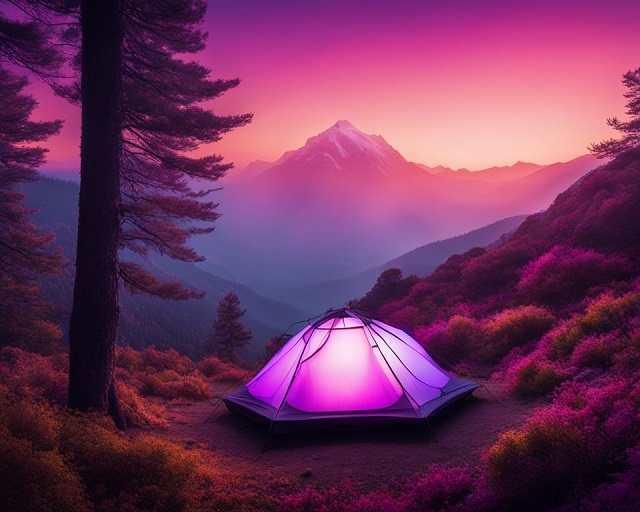Stay Updated with The Latest Hiking Tent Technologies
As the thirst for adventure beckons outdoor enthusiasts towards the embrace of nature, the demand for advanced hiking gear that can keep pace with the elements has never been higher. In the heart of this quest for exploration are the humble abodes that shelter us from the wild—the hiking tent. The latest tent technology has evolved dramatically, offering adventurers outdoor shelter innovations that turn any terrain into a home away from home.
From ultra-resistant fabrics that withstand gale-force winds to designs inspired by the efficient, geometric patterns found in nature, these tents stand as testaments to human ingenuity. With every stitch and seam sealed for durability and comfort, modern tents are no longer just a means of survival but an enhancement to the outdoor experience. This article aims to unfold the fabric of the future, presenting to you the forefront of portable home innovation.
Key Takeaways
- Unveiling the latest innovations in tent technology and how they're shaping outdoor living.
- Exploring how modern tents marry durability with comfort for the ultimate camping experience.
- Discovering lightweight designs that promise ease without compromising on space or function.
- Gaining insight into the environmental impact of the latest outdoor shelter materials.
- Anticipating the future of hiking gear, where tech meets terra firma.
- Learning about the specialized features that cater to diverse environments and preferences.
Emerging Hiking Tent Innovations for Outdoor Enthusiasts
The landscape of outdoor adventures is constantly evolving with the advent of cutting-edge tent features. Modern campers seek innovative camping equipment that defies traditional limitations, offering convenience and safety without sacrificing their connection to nature. One such leap forward in camping technology is the development of next-gen outdoor shelters equipped with advanced functionalities tailored for the discerning explorer.
https://www.youtube.com/watch?v=ZJV8UHmRUKI
Among these breakthroughs, a notable trend is the integration of environmental adaptability. A hiking tent is no longer just a seasonal shelter but is engineered to withstand a wide range of weather conditions. Below, we delve into the various features that epitomize the sophistication ushered into the realm of outdoor shelters.
- Adaptive Ventilation Systems - Tents now come with customizable ventilation options ensuring airflow optimization for any weather, minimizing condensation while maintaining interior comfort.
- Integrated Lighting Solutions - Gone are the days of fumbling with flashlights. LED lighting systems are seamlessly incorporated into tent fabrics, providing campers with illuminated sanctuaries post-sunset.
- All-terrain Adaptability - From desert dunes to alpine slopes, innovative tent structures offer stability and protection, tailored to thrive in the diversity of landscapes.
Let's put a spotlight on the structural enhancements defining next-gen outdoor shelters through the perspectives of users and industry experts:
"The shift towards multi-functional tent designs that cater to various environments is a monumental step in camping gear evolution. It's about the merge of flexibility and durability." - (Outdoor Gear Specialist)
As we explore these developments further, the overarching theme found in expert insights is a drive towards sustainability. The use of recycled materials and eco-centric designs underscores the community's commitment to preserving the very wilderness they relish.
It is this blend of innovation and eco-consciousness that paves the way for a new era of camping equipment, where experiential quality meets environmental stewardship – a true hallmark of next-gen outdoor shelters.
The Evolution of Materials in Hiking Tent Construction
The outdoor industry has witnessed a significant shift towards the development of advanced tent materials, catering to hikers looking for gear that scores high on both durability and lightness. With the next generation of lightweight camping shelters emerging, let's unfold the sophisticated fabrics leading the change and understand the sustainability strides reshaping the sphere of sustainable hiking gear.
Revolutionary Fabrics: Lightweight and Durable Solutions
Inventive materials such as ripstop nylon and Cuben Fiber have taken center stage in lightweight tent design, offering unparalleled strength-to-weight ratios. These fabrics are not only tearing resistant but are also treated with advanced waterproof coatings to withstand harsh weather conditions. The incorporation of Dyneema, for example, has become a game-changer in the industry, creating tents that are ultralight without compromising on toughness.
Environmental Impact: Eco-Friendly Materials Trends
As environmental awareness surges, the camping gear industry is pivoting towards eco-friendly production methods. Recycled polyester and PFC-free coatings are just a couple of examples showcasing a commitment to reducing environmental footprints. With brands like Patagonia and REI leading by example, there's a growing trend to adopt recyclable or biodegradable materials without sacrificing performance.
| Material | Benefits | Environmental Impact |
|---|---|---|
| Ripstop Nylon | Lightweight, durable, water-resistant | Varies; Recyclable options available |
| Cuben Fiber | Extremely lightweight, waterproof | Low; Energy-intensive production |
| Recycled Polyester | Reduces waste, comparable performance to virgin polyester | Positive; Reduces landfill and energy use |
Enhancing Comfort: Hiking Tent Interior Advances
Exploring the wilderness doesn't mean compromising on comfort. With recent advancements in tent design, the concept of comfortable camping tents has been redefined. Manufacturers are focusing on creating spaces that nurture the well-being of campers through ingenious tent space maximization and high-tech tent interiors. Let's delve into how these developments are making a home away from home in the heart of nature.
Space Optimization Techniques
Maximizing the available tent space is crucial for comfort and functionality. Designers have become adept at devising features that not only keep gear organized but also ensure that the interior space is as expansive as possible. Through smartly designed pockets to dual-function furniture, every inch of a tent is now used efficiently.
Integrated Technologies for Improved Livability
The addition of integrated technologies has made tents more than just a shelter. With built-in lighting, USB ports, and even projection areas for entertainment, the line between a tent and a living space is beautifully blurred. These features allow campers to enjoy a piece of modernity even in remote locations.
Climate Control Features for All-Weather Camping
Regardless of the weather, staying comfortable inside your tent is pivotal. Advanced ventilation systems and materials that adapt to temperature changes are being integrated into tent designs. Innovative insulation methods also ensure that whether it's a chilly night or a sweltering afternoon, the tent's interior remains a haven.
| Feature | Description | Benefit |
|---|---|---|
| Adjustable Ventilation | Systems that allow users to control air flow based on weather conditions. | Enhanced air quality and temperature regulation. |
| Convertible Sleeping Areas | Flexible interior arrangements that can be altered for daytime or nighttime use. | Multi-functional spaces that adapt to various needs throughout the day. |
| Smart Storage Solutions | Built-in compartments that maximize space while maintaining organization. | Clutter-free living area, increasing usable tent space. |
| High-Tech Fabric Materials | Innovative textiles that offer exceptional durability and climate control. | A balance between comfort in various weather conditions and long-term use. |
The progression towards more comfortable camping tents is a testament to the industry's dedication to enhancing the outdoor experience. With these interior advancements, campers can enjoy the beauty of the outdoors without sacrificing the comforts of home.
Smart Hiking Tent Systems: Integration of Modern Tech
As we journey into the realm of outdoor exploration, technological advancements have not just touched our homes and workplaces, but also the equipment we take to reconnect with nature. Hi-tech tents are transforming the way adventurers camp, bringing the convenience and safety of modern technology to the rustic settings of our wilderness retreats. Integrating these innovations, smart hiking tent systems now offer unprecedented levels of comfort and functionality, marrying the simplicity of outdoor living with the wonders of tech-savviness.
Connectivity in the Wilderness: Solar and Power Solutions
In an era where staying connected is a necessity for many, solar-powered camping solutions are breaking ground. These eco-conscious technologies allow hikers to harness the sun's energy, powering devices and lighting systems without relying on traditional power sources. Such innovations not only offer the practicality of sustained power but also ensure that our outdoor shelters contribute to a greener camping experience. By utilizing solar panels and efficient power storage units, campers can maintain communication with the outside world, while still immersing themselves in the tranquil escape that nature provides.
Security Enhancements with Smart Sensors
Camping should be an experience that offers tranquility and a break from life's buzzing, not a source of stress. Enter smart tents with sensors, which provide an additional layer of security for adventurers. These tents are equipped with technology that can alert campers to changes in weather or potential disturbances in and around their temporary homestead. The peace of mind afforded by these predictive and reactive systems means adventurers can enjoy the serenity of their surroundings, focusing on the beauty of the stars above rather than worrying about the unknown.






Comments
Post a Comment